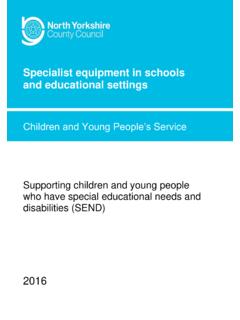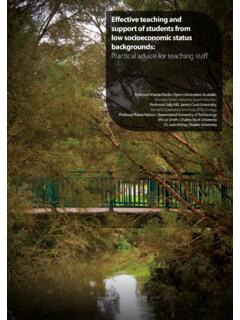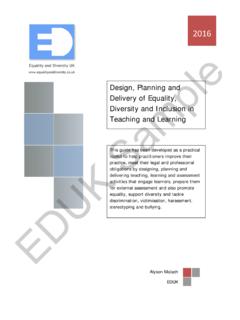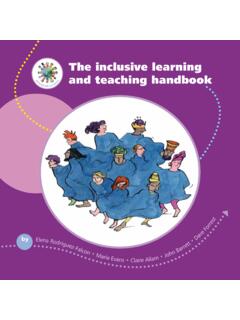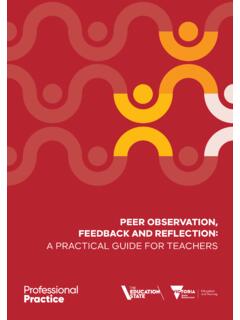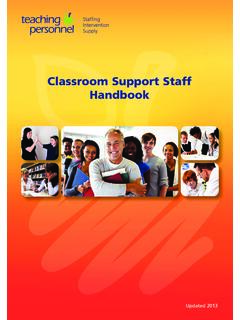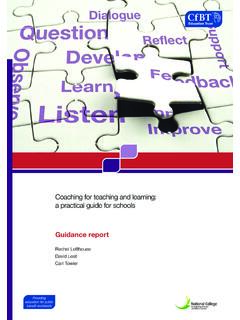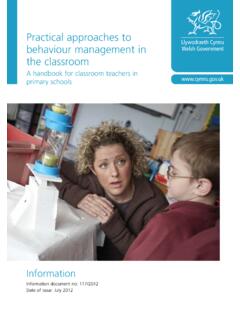Transcription of Quality First Teaching Guidance - CYPSinfo
1 Quality First Teaching Guidance Inclusive Education Service Quality First Teaching is a term regularly heard within the education sector and regularly used in the classroom by Teaching staff . It developed from a Department for Children, Schools and Families policy document called Personalised Learning A practical guide (2008). It emphasised the importance of relationships between the classroom teacher and pupils and encouraging higher expectations through higher levels of support for all pupils to succeed in their education achievements. The DfE Code of Practice (2015) states High Quality Teaching that is differentiated and personalised will meet the individual needs of the majority of children and young people. Some children and young people need educational provision that is additional to or different from this. This is special educational provision under Section 21 of the Children and Families Act 2014.
2 Schools and colleges must use their best endeavours to ensure that such provision is made for those who need it. Special educational provision is underpinned by high Quality Teaching and is compromised by anything less. The essential characteristics of Quality First Teaching are the following; 1. Clearly designed lesson plans 2. Plenty of opportunities to involve and engage with pupils 3. Appropriate use of modelling, explaining and questioning for pupils to engage with higher levels of critical thinking skills. 4. Providing pupils with the chance to talk both individually and in groups. 5. An expectation that pupils will accept responsibility for their own learning and work independently. 6. Regularly using encouragement and (authentic) praise to engage and motivate pupils. Quality First Teaching : Guidance 2 These essential characteristics are used in the classroom as teachers naturally want pupils to learn and achieve in school.
3 Teachers often differentiate for pupils to support their learning. This applies to pupils with special educational needs who might need specific aspects of the curriculum differentiated so they can be supported in their learning. This is how you can use them in your classroom to ensure all pupils receive the best educational opportunities possible. The following strategies below are based on the four broad categories of special educational need; Cognition and Learning Social, emotional and mental health Please open and save the High Quality Quality First Teaching document for specific strategies. The link provided takes to the main Cognition and Learning page, please scroll down to the Cognition and Learning toolkit. Please read the Ladder of Intervention documents for additional information to provide the best opportunities for pupils with social, emotional and mental health needs. Communication and Interaction Difficulties Sensory, physical and medical needs Speech, Language and Communication Needs Use picture-word flash cards regularly for key vocabulary Use a mini whiteboard to record instructions in First /Then format Plan time to pre-teach key vocabulary separately to using them in context Sentence starters Talk buttons Hearing loss Position the child close to the teacher with a clear sightline of them Reduce background noise and speak one at a time Use visual support to aid understanding and vocabulary development Get the pupils attention before speaking, so they don t miss the beginning Speak clearly and naturally, don t cover your mouth or mumble when talking to hearing impaired Quality First Teaching .
4 Guidance 3 Always use a pupil s name Clear and simple instructions (use SMART method) Extra time to process verbal questions or instructions Communication difficulties, including autism spectrum condition (ASC) Use visual time tables or prompts to structure routines Have a regular and explicit classroom routine Keep language clear and unambiguous at all times Avoid sarcasm Expectations made explicit Individualised social stories Calm learning environment including teacher! Anxiety monitoring cards traffic card system. pupil Ensure that the pupils hearing aids and any supported technology eg. Radio aids are working optimally Make it clear what the topic of conversation is Use subtitles for audio visual materials when appropriate Repeat others contributions Face the hearing impaired pupil when you are speaking to them, give them time to process the information Visual impairment Face the visually impaired pupil when you are speaking to them and stand away from windows with light on your face.
5 Ensure that lights are always switched on. Reduce background noise, speak one at a time and use pupils names when asking questions. Ensure the pupil is sat at the front of the class/carpet. The Physical Environment questions to ask yourself: Lighting Does the lighting in the school meet the needs of all young people? Signage Do all young people have access to curricular, environmental and social information? Colour Are colour, tone and contrast being used effectively in school? Physical Access Is the school able to provide young people with appropriate independent access? Fixtures and fittings Does the school have visually friendly fixtures and fittings? An Inclusive Curriculum: Quality First Teaching : Guidance 4 Classroom management Think Access - appropriate seating, clear and clutter free resources, contrast, easy to locate, spacing of curriculum materials, size and style of curriculum materials, pre and post Teaching .
6 Teaching Strategies follow advice from The Vision Team Planning share planning with key staff in advance Recording which is best? Handwriting- consider type of pen or use of a B pencil/ ICT/ speech/ Braille Speed of work consider reducing the quantity of work to ensure completion of task Use ICT throughout the curriculum make it accessible such as adapted settings, specialist programmes, specialist equipment, accessing interactive whiteboards, Role of support staff foster independence, adaptation of materials, support as required, develop opportunities for social interaction Curriculum areas and activities each will throw up their own issues follow curriculum specific Guidance from the QTVI Specialist aids encourage pupil to use aids as advised eg magnifiers, sloping work boards and specialist IT equipment. Physical needs For Children and young people with physical and medical needs, this is individualised for each child.
7 Please refer to their moving and handling plan and individual risk assessments for those with significant physical disabilities. Please read Guidance for Supporting CYPS with Medical Conditions in Schools for further information. Quality First Teaching : Guidance 5 This document provides general advice and Guidance . All children are unique and individual and might require additional support. Please contact the Inclusive Education Service for additional support where necessary.


